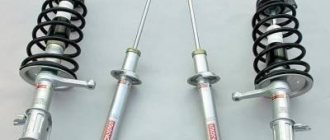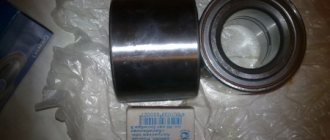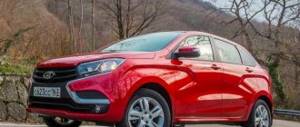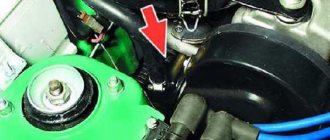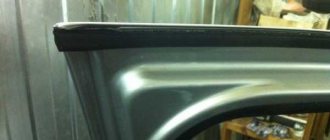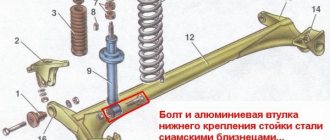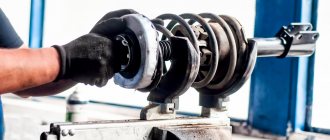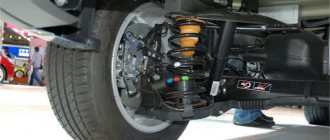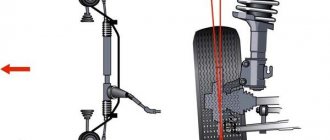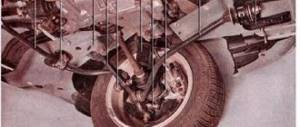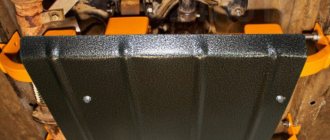The standard suspension of the Oka, which it was equipped with from the factory, is completely useless - soft oil shock absorbers and equally soft springs endowed the Oka with a number of unpleasant properties that have firmly entered into the average person’s perception of this small car - rear swaying on bumps, rolling and swaying of the car on the highway, deflation car by the flow of air from a truck passing towards - all this has been heard more than once from Oka owners.
Standard ways of tuning the suspension have been known for a long time and for many years - first of all, you need to equip the car with gas-oil shock absorbers. In past years, the choice was wide - this included the St. Petersburg Plaza, and Kony (which no one had ever seen), and the Polish Delphi. Installing gas-oil shock absorbers solved many problems - the car became much more stable, roll and sway were reduced, and the car's handling on the highway at high speeds was improved.
In recent years (2010-2012), there has been a tendency towards a reduction in the supply of shock absorbers on the Oka market - there are fewer and fewer cars (let me remind you that the car has no longer been produced since 2006 in Chelny and since 2007-2008 in Serpukhov). "Plaza" disappeared (however, considering their unstable quality and the monstrous amount of defects - it's not a pity), Polish Delphi began to disappear - which is especially sad, because The author considers these shock absorbers to be the most optimal and resourceful specifically for the Oka. You can also find and order gas-oil Monroes; the Chinese have released rear gas-oil shock absorbers “HDE” onto the market (for how long?). In Ukraine, Oka began making oil shock absorbers in Standard, Sport, Luxury variants and even gas-oil struts, but only struts in the “Standard” variant reached Chelny.
The author at one time drove about 30-40 tkm on the Plaza, after which the rear shock absorbers leaked and the front shock absorbers began to knock (the shock absorber disassembled itself). Then there was a long period (more than 100-130 tkm) of using Delphi gas-oil shock absorbers; they consistently lasted 30-50 tkm, taking into account the driving style and high speeds - a very worthy result.
The issue of further modification of the suspension was not touched upon, because the author was busy with other issues.
Experiments with springs were brief - the rear Phobos springs with variable coil pitches broke after 3-4 thousand kilometers in the Volgograd area, which caused great inconvenience - it was necessary to look for a store to buy and change the springs. In the front struts, the author tried a couple of sets of springs made by private owners (LLC, individual entrepreneur), but they became deformed after a short time and began to knock. As a result, the factory springs worked in the struts for about 180 thousand km, without any complaints.
Around 2007, the author replaced the rear springs with reinforced ones. Springs were taken from the Tavria front struts and shortened to the required height. The spring turned out to be exactly the same diameter as the original Okushnaya. But the diameter of the wire coil is 1 mm larger than Okovskaya. As a result, the rear became much stiffer, it became possible to transport cargo without significant subsidence of the rear, while the suspension became very soft - it was very comfortable to drive with a load.
But the front end remained on the original springs - it was not possible to install springs from Tavria - they were larger in diameter than the front springs of the Oka, i.e. didn't fit into the cups.
The author has been an opponent of 13-radius wheels on the Oka for many years, since they significantly increase the weight of the unsprung masses, which increases the load on the body and shock absorbers with springs - the latter stop working normally, which was repeatedly noted during test rides on other people's cars - the wheels just jump on the road, due to weak springs. Of course, everything was fine for the car owners, because the money was spent and no one would say about their car that it got worse. In addition, people did not know about replacing the rear springs (with front ones from Tavria); as a result of driving on conventional springs, the rear squatted strongly with 1-2 passengers and the wheels began to scrape on the arches and fender liners. That’s why people simply removed the fender liners (hello rot and rust in the arches), and lifted the rear with spacers for the springs. The end result was a car that was overpriced and prone to overturning. The author knows of several cases when people on the Oka River with 13 wheels simply turned their car over and parked it on its “ears.” That's why for many years I was satisfied with R12 and tires of size 1458012 - they have a high side and the diameter is only 2-3 centimeters smaller than a wheel with a tire of size 1557012 . Let me remind you that the standard tires for Oka are 1358012 .
The author also drove one autumn-winter season on a lowered Oka - the front springs were cut, there were low-profile tires in front ( 1457012 ) and standard Kama-503 ( 1358012 ) in the rear. Having felt all the charm of a puzoter in the winter of 2010-2011, when the city was not cleaned at all, and getting stuck in a yard or a local road was a matter of five seconds, it was decided to abandon lowering the car. Besides the inconvenience, this suspension tuning absolutely does not deserve attention in any way, except perhaps for the opportunity to stand out from the crowd of cars. And among the mass of cars on the road, sitting lower than everyone else is generally inconvenient both for visibility and in terms of being blinded by the light from oncoming cars at night on the highway.
In the spring of 2011, the car was raised to normal height.
In the fall of 2011, they called me and made an offer that was impossible to refuse - a set of forged R13 VSMPO wheels and two sets of tires 1557013 - winter Taganka Morozko with studs and summer Barum Brilliantis - at a very good price. The tire mileage was low, only 1 season. The kit was immediately purchased.
So, I met the winter of 2011-2012 on VSMPO forged wheels and studded winter tires. There were no problems with the rear arches - rigid brand springs held the rear well, paired with Delphi gas-oil shock absorbers. But bad things began to happen on the front axle - the heavy wheels constantly pierced the suspension - impacts from bumps and holes were hitting the body with might and main. As a test, we replaced the shock absorbers with another Delphi spare set, but the situation did not change at all - the shock absorbers literally worked for a week, then it all started all over again. I drove 4 thousand km on this suspension, went to Moscow and, having spat on the highway from endless knocks, decided to upgrade the front suspension.
At the car market, two used springs from Tavria were purchased from the front suspension. One spring had a broken part of the coil, the second spring was taken along with the strut (with the condition that the strut be returned after disassembly). 200 rubles were paid . There were no new springs, they promised to bring them in 20 days, at a price of about 1000 rubles per pair. The seller did not understand springs, so I went to the market with a barbell - the Oka has a coil diameter of 10-10.5 mm , and the Tavria front spring has a coil diameter of 11.3-11.5 mm . It is important not to buy rear T-type springs - they look the same, but the diameter of the wire turn is the same as Okushka’s - 10.5 mm .
Suspension design
The front suspension design of the Oka largely copies the VAZ-2108, but there are some differences. The main difference is the use of a subframe to fix the arms to the car body in the lower part on the VAZ-1111, while on the Eight they are connected to brackets attached to the body. Naturally, the sizes of spare parts are somewhat different.
Front suspension
The front suspension of the small car includes:
- 2 shock-absorbing struts (each of them consists of a glass, a shock absorber, a spring, an upper support);
- 2 hubs;
- 2 wishbones;
- 2 longitudinal stretch marks;
- 2 ball joints;
- 1 anti-roll bar (with struts);
A paired number of parts indicates that one complete set of them is installed on one side of the car (left, right). As for the stabilizer, there is only one in the suspension design; it is located transversely to the car and connects the suspensions of the two sides.
The suspension scheme on a car is very simple - a cup, a spring, a shock absorber and an upper support form the main component of the suspension - the shock absorber strut. In the upper part, the rack is fixed to the body by means of a support. The bottom of the strut is attached to the hub with a bolt connection (one of them is adjustable).
A transverse lever also fits the hub; it is attached to it through a ball joint. The second end of the lever is fixed in a bracket made on a subframe.
To prevent longitudinal displacement of the wheel during movement, the transverse arm is held by a longitudinal strut. This spacer is inserted into the lever at one end, where it is fixed with nuts, and at the other end it is attached to the subframe bracket.
The stabilizer is installed transversely to the car and its ends fit into the shock absorber struts. The end caps of this part are connected to the wishbones, but not directly, but through special racks. In the central part, the stabilizer is fixed with brackets to the subframe.
Since the suspension is a highly loaded unit, elastic elements made of rubber are used to reduce shock loads between its components at the points of their connection. These include silent blocks, bushings, thrust washers. These rubber elements are classified as consumables and require periodic replacement.
Features and qualities
A feature of the MacPherson suspension is the use of a shock absorber strut as a steering knuckle, which allows it to be installed on the front end. The strut plays the role of a steering knuckle thanks to the ability to rotate around an axis, and this is ensured by the use of a ball joint and a bearing included in the design of the upper support.
In addition to the rubber components, the “weak points” of the front suspension on the Oka are the shock absorbers and the upper supports.
Shock absorbers on VAZ 1111 and 11113 are made in the form of inserts (cartridges) installed in the strut cup and secured in it with a support nut.
Oil shock absorbers are installed, which are not particularly reliable. In addition, they are quite “soft”, which negatively affects the car’s handling.
The upper supports work in very difficult conditions - they bear the main load (the weight of the car, the forces coming to the rack from the wheel while driving). In addition, they take part in driving the car - thanks to the bearings included in the design of this unit, the rack rotates around its axis. All these features of the operation of the supports lead to the fact that over time they wear out and require replacement.
Rear suspension
The rear suspension is semi-independent, presented in the form of a beam consisting of two trailing arms and a spring cross member. These components are connected to each other by a permanent connection (welded).
At one end the trailing arms are attached to the body through brackets, and at the other ends the wheel hubs are attached.
The beam is depreciated by a shock absorber and a coil spring. Moreover, in Oka these elements are installed separately.
At the rear, the least reliable suspension components are the same shock absorbers and rubber elements used at the junction of the beam and brackets.
Separately, it is worth noting the springs. The coil springs, installed both front and rear, are made from small diameter rod. This provides high elasticity to the spring, but the rigidity is not enough, which makes the small car “roll” and large body rolls occur when cornering, which worsens the car’s handling.
Front suspension device
1. Ball joint of the suspension arm.
2. Lower suspension arm. 3. Anti-roll bar link. 4. Stretching. 5. Subframe bracket for attaching the brace. 6. Subframe eye. 7. Subframe spar. 8. Subframe bracket for attaching the suspension arm. 9. Anti-roll bar. 10. Clip. 11. Subframe bracket for attaching the stabilizer bar. 12. Bolts for securing the left subframe side member. 13. Front cross member of the subframe. 14. Suspension spring. 15. Front suspension strut. 16. Stabilizer bar cushion. 17. Spacer sleeve. 18. Rubber bushings for subframe mounting. 19. Thrust washers. 20. Welded body nut for fastening the subframe. 21. Body mudguard stand. 22. Upper support housing. 23. Rubber part of the upper support. 24. Upper support frame. 25. Lower support frame. 26. Thrust washer of the sliding bearing. 27. Bearing seal ring. 28. Upper spring support cup. 29. Bearing sleeve. 30. Compression progress buffer. 31. Protective cover. 32. Lower support cup of the suspension spring. 33. Bolt eccentric. 34. Suspension strut terminal bracket. 35. Bolts securing the suspension strut to the steering knuckle. 36. Steering knuckle. 37. Brake disc. 38. Dirt ring. 39. Front wheel hub. 40. Wheel hub bearings. 41. Ball joint bearing. 42. Ball joint protective cover. 43. Ball pin. 44. Rubber-metal hinge of the suspension arm. 45. Cushion for attaching the stretcher. 46. Welded body bushing for attaching the subframe. 47. Rubber-metal hinge of the stabilizer bar strut. 48. Rubber bushing for stabilizer bar strut. The front suspension is independent, of the “swinging candle” type (MacPherson type), mounted together with the power unit and steering on a subframe. The suspension is compact and simple, goes well with rack-and-pinion steering and the transverse arrangement of the power unit.
The layout of the front suspension and the specific design of a number of its components create a negative rolling shoulder when the point of intersection of the wheel turning axis with the road surface lies outside the outer part of the vehicle track. The negative rolling shoulder creates conditions for the use of a diagonal drive of the wheel brake mechanisms, in which the likelihood of the car skidding when braking is practically eliminated. This improves driving safety.
The front suspension is the connecting link between the body and the front wheels. Through the elements of the front suspension, the forces acting on the wheels are transmitted to the body. The components included in the front suspension soften dynamic loads, reduce body vibrations, and ensure good stability and smooth ride of the vehicle.
The subassembly, which includes the power unit with wheel drives, front wheel brakes, steering gear and front suspension, pre-adjusted on a special device, is mounted from below when assembling the car on the conveyor.
The subframe assembly with mounted units and assemblies is attached to the body at four points with bolts with support washers 19 through rubber bushings 18. The subframe mounting bolts are screwed into welded nuts 20 and bushings 48 of the body.
The subframe consists of two longitudinal spars 7 and a front cross member 13, made of pipes. They are connected to each other: the right spar and cross member by welding, the left spar and cross member with bolts 12. Support 5 (see Chapter 26) of the steering mechanism is bolted to the rear of the side members. The bolted connection of the left side member with the cross member 13 (see Chapter 23) and the steering gear support 5 (see Chapter 26) allows you to remove the gearbox from the vehicle without removing the entire subframe with the units and components installed on it.
Welded to the subframe side members are: brackets 11 for attaching the stabilizer bar 9, brackets 8 for attaching the suspension arms, brackets 5 for attaching the braces 4, as well as brackets for attaching the power unit. At the ends of the cross member 13 and behind the side members, lugs 6 are welded for attaching the subframe to the body.
The suspension consists of a guide device, elastic and damping elements.
The suspension guide determines the nature of the movements of the wheels relative to the body, and also transmits forces and moments from the wheels to the body. The guiding device includes a lower lever 2 with a stretcher 4, a telescopic stand 15 and a steering knuckle 36 that connects the stand and the lever to each other. The guide device also includes a rod 9 of the anti-roll bar.
The lower V-shaped suspension arm is formed by a forged transverse arm 2 and a rod brace 4 directed rearward. The extension is connected to the transverse arm with a bolt in one position, in which mark A (rib) on the extension is directed upward. The other end of the brace is connected to the front bracket 5 of the subframe by means of two nuts and rubber pads 45 with thrust washers 19. By moving the brace, carried out by screwing or rolling up the nuts of its fastening, the longitudinal inclination of the turning axis is adjusted.
When the suspension moves, lever 2 rotates within the limits of elastic deformation of the rubber-metal hinge 44 and rubber pads 45. In this case, rotation of the rubber-metal hinge in the lever socket or its bushings relative to each other is not allowed.
Telescopic suspension strut 15 is double-pipe, double-acting, with variable fluid flow. The telescopic stand combines in one unit the functions of a load-bearing and guiding device, as well as a damping element.
The upper part of the rack 15 is attached to the rack 21 of the body mudguard with two self-locking nuts through a highly elastic support 22. The design of the upper support ensures that the rack “swings” when telescoping and good damping of high-frequency vibrations transmitted by the tires to the body. The rotation of the rack when the wheels turn is ensured by a plain bearing (pos. 26, 29) located in the upper support 22.
The lower part of the rack 15 is connected to the steering knuckle 36 using a terminal bracket 34 with an eccentric device for adjusting the camber of the front wheels.
The following are installed on the telescopic stand: a coil spring 14, a polyurethane foam buffer 30 of the compression stroke (elastic suspension elements) and an upper support assembly with a plain bearing and fastening bolts. The suspension spring is installed between the upper 28 and lower 32 support cups. The lower cup 32 is welded to the suspension strut, the upper cup 28 is attached together with the support to the strut rod. The compression stroke buffer 30 is installed on the rod assembly with a protective casing 31, which protects the rod from mechanical damage.
Spring 14 is made of special spring steel and, depending on the length under the control load, is divided into two classes: A and B. Class A springs are marked with yellow paint on the outside of the middle turns, and class B springs are marked with green.
The compression stroke buffer 30 limits the compression stroke of the suspension. At the moment of limitation, the buffer support, pressed onto the body of the telescopic stand, rests against it. The buffer is made of fine-mesh polyurethane and has two annular grooves on the outer surface that determine the location of the buffer deformation. A polyethylene protective casing 31 fits into the third lower annular groove.
Malfunctions and their symptoms
The main malfunctions of the suspension of the VAZ Oka car are:
- Wear and damage to rubber elements (silent blocks, bushings, support washers);
- Leakage of working fluid from the shock absorber;
- Wear of the ball joint;
- Spring damage;
- Wear of the upper support;
The front suspension has a direct impact on the car's handling, so any faults in it will negatively affect the car's behavior on the road. The condition of the rear suspension, although it affects handling to a lesser extent, its technical condition is also important.
Symptoms of problems are:
- Knocking in the front suspension, squeaks (when driving through an area with uneven surfaces);
- Incontinence of the rut (when driving on a straight section, it is necessary to steer in order to maintain the trajectory);
- Deterioration in controllability;
- Uneven tire wear;
- Steering wheel vibration when braking;
There are also more specific signs, for example, a clearly noticeable misalignment of the car, which happens in the case of a broken spring.
Note that some symptoms may indicate malfunctions in other components of the chassis - wheel hubs, steering, brake system. Therefore, to more accurately determine the cause, diagnostics of these nodes is necessary. After this, the chassis is repaired, which involves disassembling its components, troubleshooting and installing new spare parts to replace worn ones.
Wear and tear of consumables is the most common reason for the need for suspension repairs. Silent blocks, bushings, washers provide vibration damping during suspension operation. But these parts are made of rubber, which is subject to “aging” and delamination. As a result, their work efficiency decreases. In addition to the environment, the condition of rubber components is also affected by the operating conditions of the vehicle.
Restoring the performance of the suspension is carried out by replacing worn consumables (they cannot be repaired).
The shock absorbers are also not highly reliable, and due to their excessive “softness,” the performance of these components on the Oka leaves much to be desired. Their most common failure is the appearance of a leak of working fluid. Such a malfunction leads to a malfunction of the part. Damage to the shock absorber rod or housing is less common.
Symptoms of problems with the shock absorber are traces of oil on the strut cup, strong knocking (“breakdowns” of the shock absorber) when driving over uneven surfaces.
The ball joint is the lower support point of the suspension, so it does not bear quite heavy loads either. Over time, this joint wears out, which leads to knocking noises (when hitting bumps) and deterioration in handling. This spare part is also non-repairable and must be replaced when critical wear occurs.
Diagnostics
Any malfunction of suspension components affects the geometric parameters of this component (changes in toe, camber, and longitudinal inclination of the steering axis). The consequence of geometry violation is deterioration in car handling and uneven tire wear.
Diagnostics of the suspension is a simple operation. At service stations it is performed on special stands, but it can be done with your own hands.
Self-checking the condition of the diagnostics comes down to a visual inspection and applying force to certain points.
When inspecting, pay attention to all rubber elements. Cracks or delaminations on them will indicate wear of the consumable and the need to replace it.
After examination, the diagnosis is performed as follows:
- We put the car on the inspection hole;
- We climb under the car and take the tire iron;
- We insert a pry bar between the wishbone and the subframe. Swing the lever;
- In the same way, we check the condition of the stabilizer link;
- We hang up the front of the car;
- Holding the wheel, swing it in the transverse direction (pull “from yourself to yourself”);
By applying force, play is checked at the joints (in a working suspension there should not be any). If there are backlashes, they will appear in the form of knocks. This way, the key connection points are checked - the arms to the brackets and the hub, the upper support to the body, as well as the condition of the ball joint.
The rear suspension is checked in the same way - but in it, force should be applied to the cross members of the beam to check the condition of the silent blocks.
If the diagnostics reveals backlashes, the suspension is repaired, which consists of disassembling it, defacing it and installing new spare parts.
Front suspension structure of the OKA VAZ-1111 - 1113 car
Front suspension OKA : 1 — brake disc; 2 — wheel hub bearing; 3 — front wheel hub; 4 — splined tip of the outer hinge body; 5 — hub cap; 6 — wheel mounting stud; 7 — steering knuckle; 8 — bolts securing the strut to the steering knuckle; 9 — eccentric of the adjusting bolt; 10- telescopic stand; 11 — upper spring support cup; 12 — sleeve bearing; 13 — bearing sealing ring; 14 — thrust washer of the sliding bearing; 15 — lower support cage; 16 — upper support cage; 17- upper support of the rack; 18 — rubber insert of the upper support; 19 — compression stroke buffer; 20 — protective housing; 21 — suspension spring; 22 — lower spring support cup; 23 - stretching; 24 — lower suspension arm; 25 — ball pin; 26 - ball joint.
The front suspension is independent, with telescopic hydraulic shock absorbers, coil springs, lower wishbones with braces and a stabilizer bar.
The basis of the suspension is a telescopic hydraulic shock absorber strut; parts of a telescopic hydraulic shock absorber are mounted in its body. The lower part of the strut is connected to the steering knuckle with two bolts. The top bolt passing through the hole in the strut bracket has an eccentric collar. By turning this bolt, the camber of the front wheel is adjusted (see below). The telescopic strut is equipped with: a coil spring, a polyurethane foam compression stroke buffer, a protective cover, as well as an upper strut support assembly with a bearing. The upper support is attached with two self-locking nuts to the body mudguard strut. Due to its elasticity, the support allows the strut to swing during suspension movements and dampens high-frequency vibrations of the body. A bearing pressed into it allows the rack to turn along with the steered wheels.
The lower part of the steering knuckle is connected to the lower suspension arm through a ball joint. The support is secured with two “blind” bolts. The inner end of the suspension arm is connected through a rubber-metal joint to the subframe bracket.
Braking and traction forces are perceived by longitudinal braces, rigidly connected (bolted) to the suspension arms, and - through rubber cushions - to the subframe brackets. The cushions are compressed with washers and nuts. By moving the nuts along the threaded part of the extension, the angle of longitudinal inclination of the rotation axis is adjusted (see below).
A double-row angular contact ball bearing of a closed type is secured in the steering knuckle with two retaining rings. The wheel hub is installed with tension in its inner rings. The bearing is tightened with a nut on the shank of the outer wheel drive joint housing and is not adjusted during operation.
Anti-roll bar - spring steel rod. The ends of the stabilizer are connected to the lower suspension arms through struts with rubber and rubber-metal hinges. The middle part of the rod is attached with brackets through rubber pads to the subframe.
Tuning and improvements
As already, the front suspension on the Oka leaves much to be desired, so many small car owners are interested in how to strengthen the suspension and improve its performance. Suspension tuning helps a lot in this matter.
Conventionally, tuning of this component on the VAZ-1111 can be divided into two categories - with minimal impact on geometric parameters and serious alteration.
In the first case, reworking the suspension comes down to replacing the shock absorber and installing rubber elements with improved characteristics. The front suspension spring does not change in this case.
On the Oka, in addition to factory shock absorbers, you can install similar parts from other cars, but here it is important to take into account their dimensional parameters, in particular the length.
The front shock absorbers of the VAZ-1111, for example, are similar to the front shock absorbers from the Chevrolet Niva, VW Jetta/Golf 2. But the former, when fully extended, are 1 cm shorter than the “original” ones from Oka, and the shock absorbers from VW, on the contrary, are longer by 3 cm. Therefore, their installation will entail a change in ground clearance. But as an option, the rod on the Jetta 2 parts can be ground down by 3 cm and a thread can be cut on it, thereby adjusting the part to the required dimensions.
In both cases, replacing the shock absorber with a stiffer one will have a positive effect on the car’s handling and will reduce the “rolliness” of the car, and at the same time, the alteration will have virtually no effect on the geometry of the entire unit.
As for the serious modification of the suspension, everything here depends on what the owner wants to get as a result. For example, some “Okovody” make a kind of crossover out of a small car. And for this, a suspension lift is performed, which boils down to adding spacers to the strut design, while the shock absorbers are also replaced with higher ones. As a result, the car is significantly “lifted” - its ground clearance increases.
In general, there are many modification options and they are, by and large, limited only by the imagination of the car owner. Some only strengthen the suspension, others modify it using components from other cars, and others practically develop it from scratch, adapting it to certain operating conditions of the car.
Front shock absorbers
The strut with shock absorbers is the most heavily loaded unit. It is entrusted with the functions of monitoring the adhesion of the wheels to the road surface and participating in the control of the vehicle. The Oka is a fairly light machine, so the serviceability of this unit plays a very important role.
The strut is a hollow glass with a knuckle attached to the knuckle of the hub mechanism, into which the shock absorber liner is inserted and secured with a lock nut. To impart rigidity, it is provided with a support platform for a spring, which gives the Oka machine the necessary vertical stability parameter. The strut is attached to the car body using a support platform that contains a bearing called a thrust bearing.
The support bearing is mounted into the mounting platform; the upper end of the shock absorber rod with a thread is inserted into its inner part and secured with a nut. This bearing allows the shock absorber to turn after the wheels and at the same time dampens the angle of inclination of the body to the rigid rod. The lower part of the mechanism is secured to the steering knuckle with two bolts, one of which adjusts the camber angle of the wheel.
Thanks to this design, the stand with a shock-absorbing insert for the VAZ 1111 is very simple, reliable and extremely functional.
